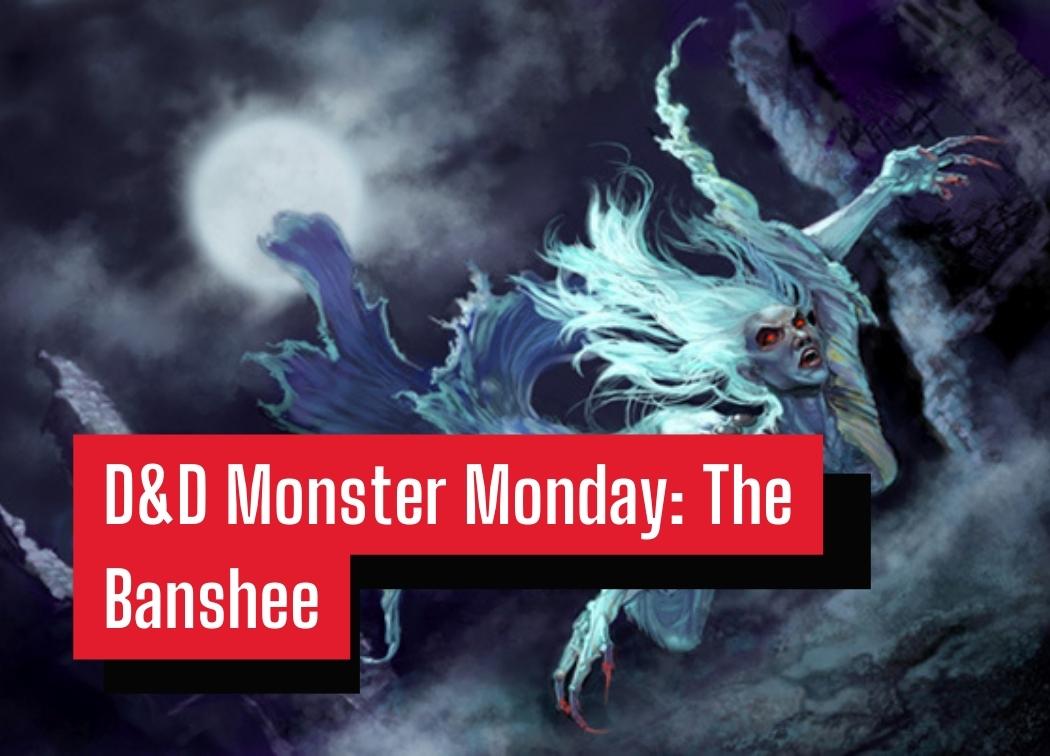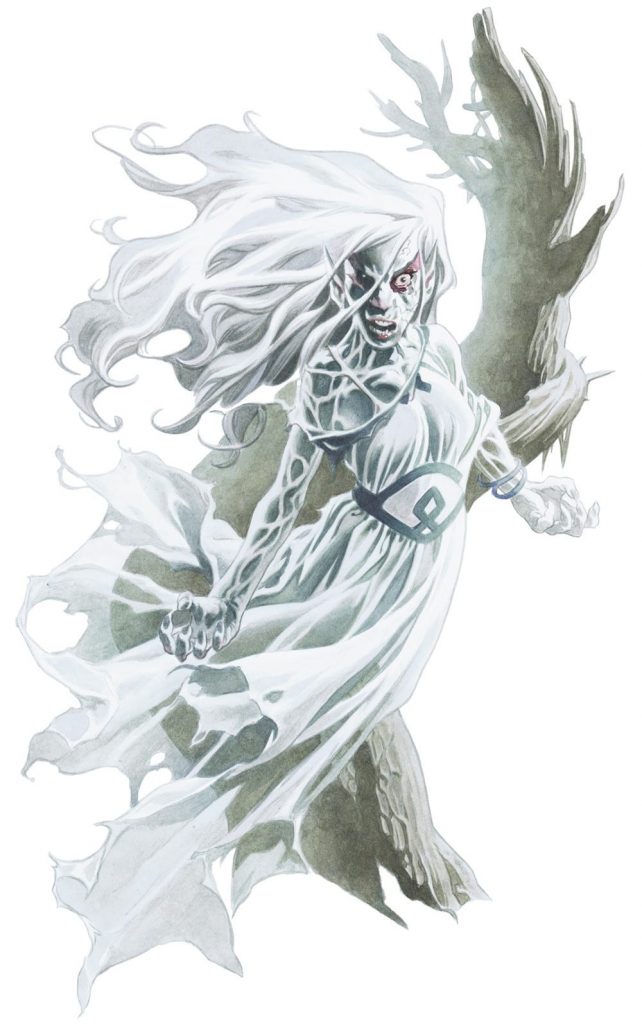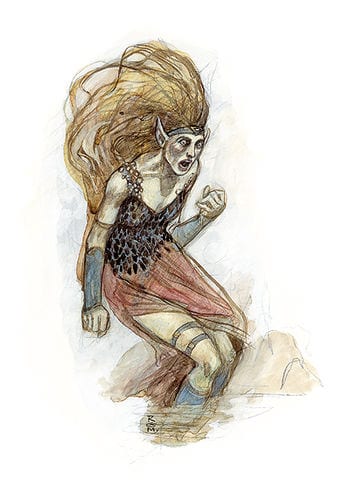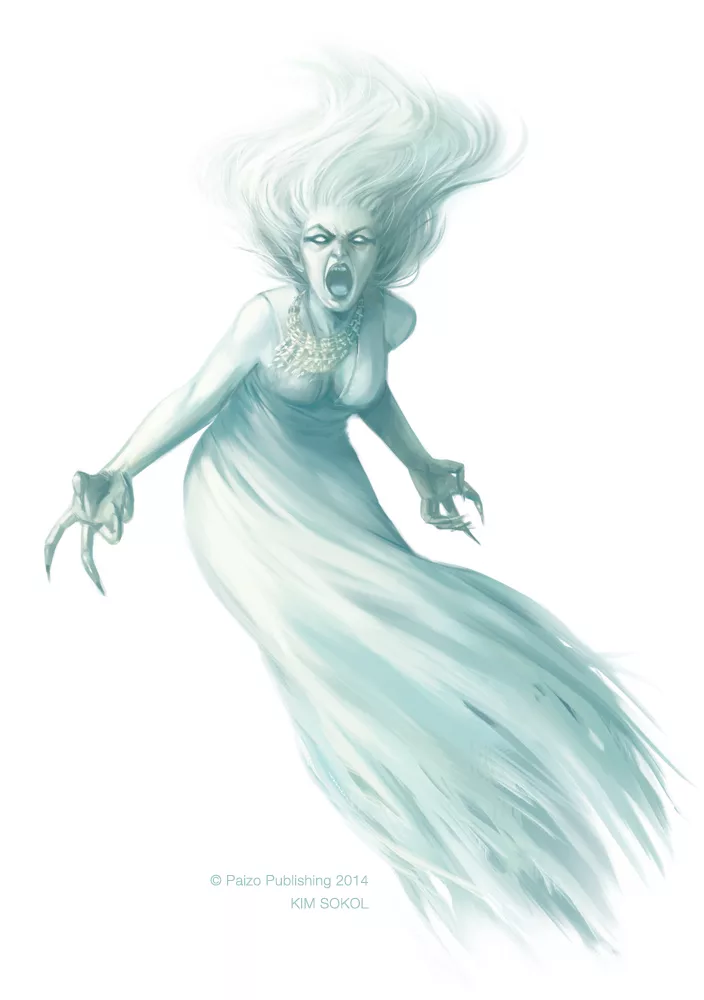D&D Monster Monday: The Banshee

In this bi-weekly series, I talk about some of my favorite D&D monsters both official and homebrew. This week we take a look at one of my new favorite monsters, the banshee.
My players had been exploring the catacombs of an ancient high elf city that had been destroyed in a disaster. Throughout their exploration, they found many undead foes that they had to slay. None of these creatures were much of a threat to the party until they met their first banshee. Her wail of terror brought two of the level 9 heroes to their knees.
A banshee is an undead creature that specializes in two things. The first is their mobility and tracking abilities within a 5-mile radius. The second are their fair, but very powerful crowd control AoE abilities. Even at higher levels, this CR 4 creature can truly strike terror in the hearts of your players with their unique ability to drop a creature to 0 hit points.
Banshee Lore
In D&D 5e, banshees were once very beautiful female elves during their life. However, these were also evil and corrupt elves that used their beauty and a long lifespan for evil. Due to their evil deeds and nature, they were given The Banshee’s Curse.
The Banshee’s Curse: Upon their death, the elf changed into a horrifying undead creature, a banshee. They have no feeling, no beauty, and their bodies will continue to decay until they become truly abominable. On top of this, they are locked into staying within 5 miles of their place of death.
Banshees are cursed to feel distressed when they are within the presence of a living creature. This is because they are reminded of what they once were, a beautiful living being. Slowly they will begin to loathe the living and make it a point to seek out and slay any that come within 5 miles of their domain.
Banshee Stats and Abilities

Let’s go over the base abilities and stats of a D&D 5e banshee so we can get an idea of what the role of this monster is. All of these stats and abilities can be found on page 23 of the Monster Manual.
Base Stats
- Size: Medium
- AC: 12
- HP: 58 (13d8)
- Speed: 0 ft., fly 40 ft. (hover)
- STR: 1 (-5)
- DEX: 14 (+2)
- CON: 10 (+0)
- INT: 12 (+1)
- WIS: 11 (+0)
- CHA: 17 (+3)
Overall the banshee has fairly low stats and AC. However, their 40 ft. of flying gives them the ability to outpace most PCs. Their health is also pretty solid for such low stats and AC. Their main source of survivability comes from their long list of damage resistances and immunities.
Resistances, Immunities, Saves, and Skills
- Saving Throws: WIS +2, CHA +4
- Damage Resistances: acid, fire, lightning, thunder; bludgeoning, piercing, slashing from nonmagical weapons
- Damage Immunities: cold, necrotic, poison
- Condition Immunities: charmed, exhaustion, frightened, grappled, paralyzed, petrified, poisoned, prone, restrained
- Senses: darkvision 60 ft., passive Perception 10
- CR: 4
Banshees basically have a laundry list of resistances and immunities. Outside of force, psychic, radiant, and slashing, piercing, bludgeoning damage from magic weapons the banshee will take either half or no damage from that damage source. While they are easy to hit, most of the players’ spells and abilities will not be dealing their full damage.
Coming back to the maneuverability comment that I made earlier, banshees are immune to most forms of crowd control. Even then, they have bonuses for both WIS and CHA saves which are both fairly common saves for crowd control spells and abilities for the few conditions they aren’t immune to. It’s very difficult to hinder a banshee’s movement.
Abilities
Detect Life. The banshee can magically sense the presence of living creatures up to 5 miles away. She knows the general direction they’re in but not their exact locations.
Incorporeal Movement. The banshee can move through other creatures and objects as if they were difficult terrain. She takes 5 (1d10) force damage if she ends her turn inside an object.
Both of these abilities establish the banshee’s role of being a hunter and killer of living beings. Detect Life gives them the general location of any living creature within 5 miles. With Incorporeal Movement they can move through solid objects giving them even more maneuverability in combat. At this point, if she wants you dead, she will move through anything and anyone to get to you.
Actions
Corrupting Touch. Melee Spell Attack: +4 to hit, reach 5 ft., one target. Hit: 12 (3d6 + 2) necrotic damage.
Horrifying Visage. Each non-undead creature within 60 feet of the banshee that can see her must succeed on a DC 13 Wisdom saving throw or be frightened for 1 minute. A frightened target can repeat the saving throw at the end of each of its turns, with disadvantage if the banshee is within line of sight, ending the effect on itself on a success. If a target’s saving throw is successful or the effect ends for it, the target is immune to the banshee’s Horrifying Visage for the next 24 hours.
Wail (1/Day). The banshee releases a mournful wail, provided that she isn’t in sunlight. This wail has no effect on constructs and undead. All other creatures within 30 feet of her that can hear her must make a DC 13 Constitution saving throw. ON a failure, a creature drops to 0 hit points. ON a success, a creature takes 10 (3d6) psychic damage.
Both Wail and Horrifying Visage are extremely powerful AoE moves. Fortunately for your players, they each have a single use each day. While Horrifying Visage is able to be cast multiple times per day, your players will only be affected by the fear a maximum of once every 24 hours until they are immune to it. Wail has the potential to either do an average of 10 psychic damage OR drop a creature to 0 hit points. That’s an insane amount of damage. This is still a fair move as it is a very low Constitution save, and let’s be real no one uses CON as their dump stat.
Corrupting Touch is a decent ability, though its drawback is that the banshee has to go into melee range. Realistically, she would want to avoid using this ability until she’s been able to affect a couple of people with either Wail or Horrifying Visage. The banshee should not be trying to play fair, she should avoid being able to be hit until she is able to close the gap on her prey.
Banshee Strengths
The primary strengths of the banshee is their maneuverability and their AoE crowd control. This allows them to chase down their victims and give themselves a way to get a jump on a softened-up group of adventurers.

Maneuverability
It goes without saying that 40 ft. fly speed while hovering is insanely useful for maneuverability. 40 ft. anything movement is faster than most PCs’ base movement. Coupled with her Incorporeal Movement, a banshee can rush straight to their target without much effort. Banshees are also able to avoid any traps or environmental elements that would hinder the movement of creatures that have to touch the ground.
Being immune to the vast majority of CC conditions in D&D 5e is a huge bonus to being able to dash around the battlefield. Plus having a bonus to Wisdom saving throws is another advantage of avoiding a lot of crowd control spells and abilities such as Turn Undead and Turn the Unholy.
AoE Crowd Control
Horrifying Visage gives the banshee a way to avoid taking damage by potentially imposing frightened on any non-undead creature within 60 feet. This imposes disadvantage on attacks against the banshee improving their survivability.
Creatures also can’t move closer to the source of their frightened condition meaning that melee-focused characters can be screwed-over pretty easily. The best part of this ability is that so long as the banshee is within line of sight, the creature has disadvantage on removing this effect when it makes additional saves.
Wail has the ability to drop a creature or player down to 0 hit points. It is a DC 13 Con save which should be easy to overcome for most high-level characters. However, there is a decent chance that a banshee can eliminate at least one enemy from the fight when they use Wail. Even if the creatures make the save they still take an average of 10.5 psychic damage. This is an extremely powerful opening ability for the first round of combat.
Using these abilities in tandem will give the banshee a great chance at knocking out one or more enemies without risking their safety. But damage isn’t crowd control! It totally is if it takes an entire enemy out of the fray for at least one round.
Banshee Weaknesses
Low AC
Outside of their uses of Wail and Horrifying Visage the banshee is a melee attacker. While they have plenty of resistances and immunities, they are still very easy to hit with 12 AC.
Any enemy of the banshee that can either close the gap early in the fight or attack regularly from over 60 ft. away is at an advantage. A PC or creature that can attack from beyond 60 ft. will completely avoid both AoE abilities.
Conversely, a melee creature or player with a lot of movement can get to the banshee before she’s unleashed both. Players with a large bonus to Wisdom Saving throws also can generally avoid the two abilities. Due to the banshee’s low AC, these types of enemies can hit the banshee easily and not be deterred by her AoE CC.
Clerics
Banshees are undead, and being undead they are extremely susceptible to Cleric and Paladin abilities.
Clerics have two abilities outside of their spell choices that make them the bane of an undead creature’s existence. Turn Undead allows them to use their Channel Divinity feature to make any undead that can see or hear them only able to use its Dash action to move away from the Cleric should they fail a Wisdom saving throw. They also can’t use reactions or move within 30 feet of the Cleric.
Destroy Undead is another Cleric ability that ruins your undead minions. If the creature is of an appropriate CR they will be destroyed if they fail the Wisdom saving throw when the Cleric uses Turn Undead. A banshee would not be destroyed unless the Cleric is level 17 or higher so this isn’t going to be frequently applicable, but still, it’s worth mentioning.
Paladins
Paladins gain an extra 1d8 radiant damage when they use their Divine Smite. This is one of the few damage types that banshees are not resistant/immune to which makes this ability even more powerful against them. Like their Cleric counterparts, Paladins can also use Turn the Unholy to force creatures to flee from the Paladin should they fail the Wisdom saving throw. Turn the Unholy works the same way as the Cleric’s Turn Undead but it can also be used on Fiends.
Like any other undead creature, if there is a Cleric or a Paladin in the party composition, your banshee is going to have a rough time.
How to Play a Banshee

The Huntress
Given their ability to track down any living being within 5 miles, banshees make great hunters. They also have darkvision which allows them to sneak up on unsuspecting prey as they settle down for the night. Their mobility is also a great boon for running down their unsuspecting victims, as well as running away from them should they be too much to handle!
Their +2 to DEX and ability to hide inside of solid objects is also useful for potentially sneaking up on their enemies.
Provides Support
Group a banshee together with a few other undead creatures. None of the banshee’s AoE abilities will affect them. This will allow the minions to take advantage of any openings that a banshee’s Wail or Horrifying Visage will provide. If a player or two drops to 0 hit points, the minions can quickly move in and attack their remaining enemies.
This also forces the party to focus on reviving any party members that succumb to Wail. If there is more of a chance that the minions will carve up their allies that are bleeding out, a player will spend their action economy focusing on revival rather than fighting the enemies.
Weaving In and Out of Line of Sight
Even though they’ll take a bit of damage, it is still an option to hide within a wall or object at the end of their turn. That 1d10 damage is well worth the trouble if they can avoid being targeted by their enemies. Many ghosts and apparitions like banshees have this ability. Use it in such a way that your creature is able to avoid a lot of damage from the players while still being a nuisance on their turn.
This strategy will be risky since you’ll be taking damage if you end your turn within a wall. Enemies frightened by your Horrifying Visage also have disadvantage on the save while you are within line of sight. Keep both these scenarios in mind when using this tactic.
Conclusions
The banshee is one of my recent favorite creatures in D&D 5e. Their potential to drop even a high-level player down to 0 hit points makes them always a threat. They are especially deadly when coupled with other undead, or getting the jump on an unsuspecting party. To cap it all off, they have some pretty interesting lore that forces them to have some unique play restrictions.
Banshees are one of a few creatures that I find make a great low-level boss monster or part of a standard high-level encounter. They have both interesting mechanics for a threatening encounter as well as the lore to justify them being a boss encounter. Their AoE CC also makes them a deadly addition to any encounter even for mid to high-level campaigns.
Check out page 23 of the Monster Manual if you are looking to learn more about banshees!
